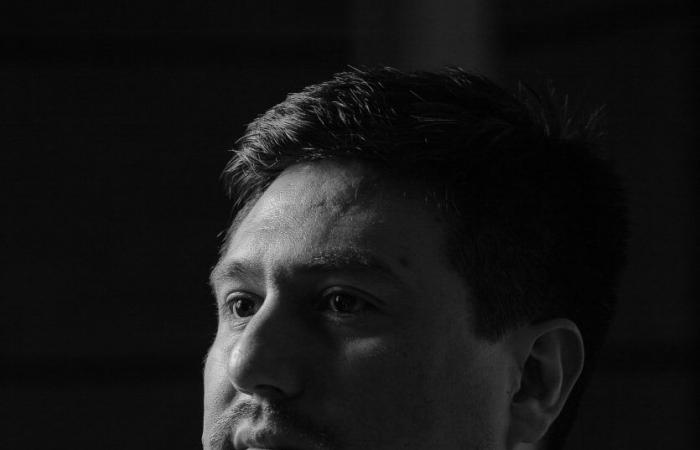One of the writers of the Yosuke Kuramochi Poetry Collection of the Catholic University of Temuco will exhibit his collection of poems at the Manuel Rojas Economic Culture Fund Bookstore next Saturday, June 22 at 4 p.m. Caro will be accompanied by the poets Claudia Jara and Patricio Alvarado.
Felipe Caro, poet from Temuco, author of “Nothing or the Observable Void of Space”, a work published by Ediciones Universidad Católica de Temuco at the end of 2023 and part of the first Call “Yosuke Kuramochi Poetry Collection”, will be presented for the first time in Valparaíso, specifically at the Manuel Rojas Economic Culture Fund Bookstore (Paseo Yugoslavo #176, Cerro Alegre) next Saturday, June 22 at 4:00 p.m.
hours.
“Nada…” is published after participating in this instance, which received collections of poems under the sole premise that they had to be poets born or resident in the region of La Araucanía. After the evaluation of the 47 proposals that were received, reviewed by voices such as the poet and professor Rosabetty Muñoz; the academic and poet, Patricio Alvarado; or the Cuban writer residing in Chile, Carlos Lloró, Caro was one of the two selected – along with the work
«Bird watching and other flights» by Carla Llamunao-.
In “Nothing or the Observable Void of Space,” the poet offers a reading experience defined by Lloró in his introduction as “hypnotic,” where the poet’s voice has reached a new maturity and transparency. With three previous publications. «Daughter» (Poleo Ediciones, 2010), «Nadir» (Bogavantes, 2017) and «Pieza País» (Libros del Perro Escondido, 2021), Caro explores on this occasion the connection between the cosmos and the routine.
It is the Cuban author who highlights that Felipe Caro creates a combination of minimalism and depth, to address topics such as the connection between space and humanity. In his poems, images of Soviet cosmonautics, such as the first rocket of the Vostok space program and the Mir space station, are intertwined with everyday life and human emotions.
Felipe Caro’s new book will be presented in Valparaíso by Claudia Jara and moderated by Patricio Alvarado. Given the activity to come, the author answers some questions.
-«Nothing…» was chosen with C. Llamunao’s poetry collection among more than 40 applicants. What could you tell us about the call that the poets received in such an unusual contest in these times in the region?
I think UCT took on a responsibility that no one wanted to take on. Seeing what is happening and doing something with it is important in these times. Although self-management and other forms have helped sustain literature, these instances are always important.
-Your collection of poems “Nada…” is the fourth one you have published so far, how have your previous works influenced your current work?
Writing is always a transit accompanied by reading. Each book is a project that tries to be a work. The dialogue between the works demonstrates the tensions and explorations that they try to propose. The books are related, although their spine is always a tension that once again notices its presence.
-How did this connection of the poems between the cosmos and the routine/mundane that you explore in “Nada…” come about?
I think books have their ways. The topic arises like everything that matters, without noticing it. You realize that it was always a noise that accompanies you. A journey that seeks to enter the universe is as uncertain as the future of our lives.
-What interests you about Soviet cosmonauts over American astronauts or Chinese taikonauts?
I am interested in its origin. Gagarín worked as a young man in a steel foundry, became a pilot and then went to space. Valentina was a textile worker, a parachutist and then orbited the earth. I like to think that poetry has that. Common and simple words are transformed into a poem that makes noise to someone who reads.
-What are you trying to talk about in this collection of poems? Was it something thought out or lacks intentionality?
There is always an initial intention that is lost and rediscovered in the process. I think the title contains something of what I was looking for in the book, what is there in nothingness? What is what we call emptiness made up of?
-What artistic works, whether music, cinema or paintings, influenced the work during its composition?
At first I wanted to link each poem to a work associated with the space (films, songs, series, etc.), but I considered that I would limit the transit of each poem. Obviously there are a series of works that I love in science fiction. Space and time travel are topics that I like to consume.
-You have a relationship with other poets in the region, while maintaining your teaching work. What do you see in the poetic environment? what is being written about? How do these personal experiences influence your poetic work?
Poetry persists on its own. I have been fortunate to know many writings from different generations and I admire several. The themes are limited and repeated. The value is in the voice with which one dialogues in literature. The important thing is to read them. Writing is a decision that is sustained over time. Regarding the teaching experience, there are always planes of resonance that are sustained, but I think there is a beautiful work in proposing a space in the
literature so that it is inhabited by the students.
Photography by Mauricio Ascencio Zúñiga.


